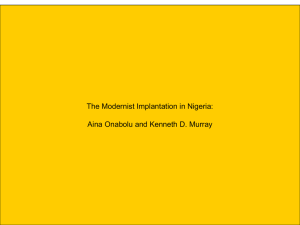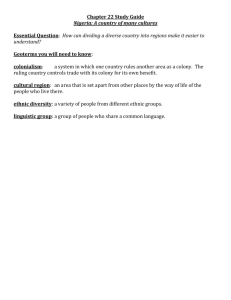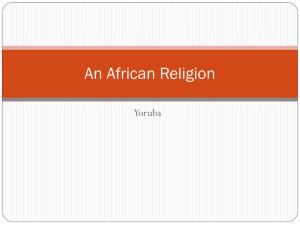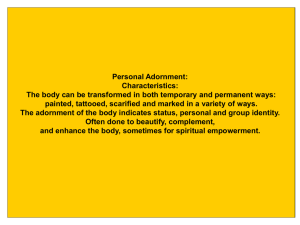Use of Indigenous Languages as Media of Instruction in Teaching of
advertisement
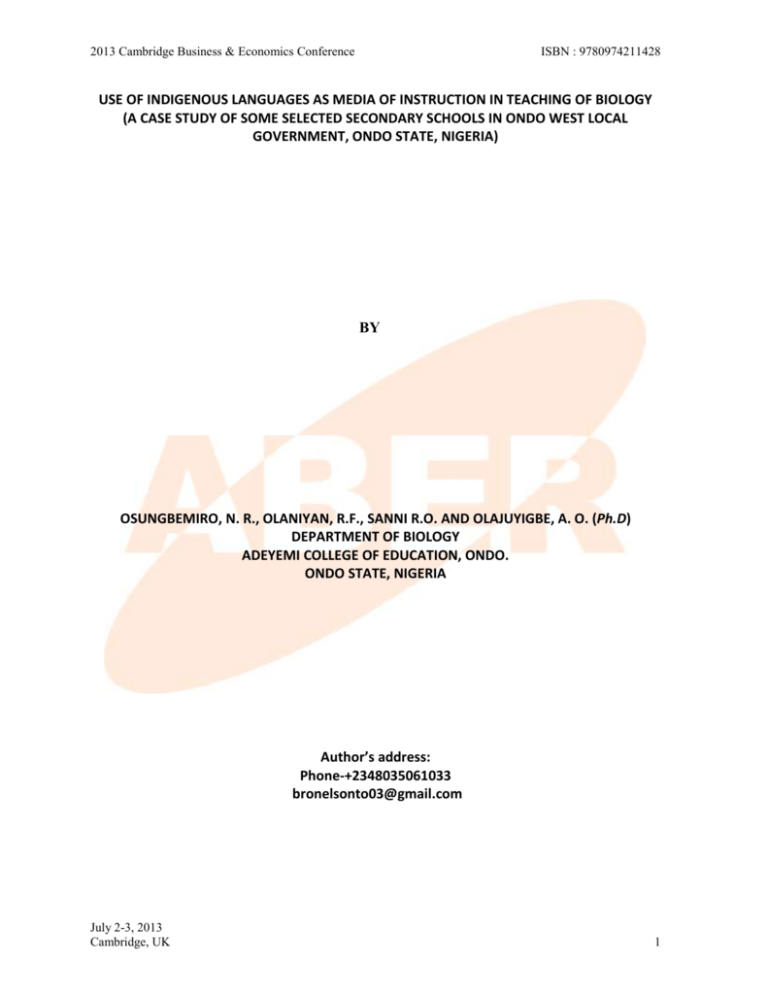
2013 Cambridge Business & Economics Conference ISBN : 9780974211428 USE OF INDIGENOUS LANGUAGES AS MEDIA OF INSTRUCTION IN TEACHING OF BIOLOGY (A CASE STUDY OF SOME SELECTED SECONDARY SCHOOLS IN ONDO WEST LOCAL GOVERNMENT, ONDO STATE, NIGERIA) BY OSUNGBEMIRO, N. R., OLANIYAN, R.F., SANNI R.O. AND OLAJUYIGBE, A. O. (Ph.D) DEPARTMENT OF BIOLOGY ADEYEMI COLLEGE OF EDUCATION, ONDO. ONDO STATE, NIGERIA Author’s address: Phone-+2348035061033 bronelsonto03@gmail.com July 2-3, 2013 Cambridge, UK 1 2013 Cambridge Business & Economics Conference ISBN : 9780974211428 Use Of Indigenous Languages As Media Of Instruction In Teaching Of Biology (A Case Study Of Some Selected Secondary Schools In Ondo West Local Government, Ondo State, Nigeria) ABSTRACT There is no doubt that the performance of students in Biology in Nigeria secondary schools has fallen drastically. The aim of this research is to investigate whether the use of indigenous language (mother tongue) can improve scientific development in this part of our world. The research is conducted in four schools in Ondo West Local Government Area. The research is carried out systematically with the use of teaching method in which the pupils are taught in a specific mother language (Yoruba language) and with a foreign language (English language). Pretest and posttest were administered, summative evaluation were carried out with each language of the topic taught and the scores collected from the evaluation were analyzed with the use of T-test analysis to show the mean scores of the languages respectively. The findings showed that there is a significant difference between the students taught with indigenous language (Yoruba language) and those taught with English languages: Therefore, effort should be made towards encouraging the indigenous language to teach our students at all level of Education; however, this should be complimented with foreign language. INTRODUCTION In Nigeria, English Language is the medium of instruction as from primary to tertiary level. This medium of instruction is different from the language of the immediate environment or mother tongue of the child, therefore, English is a second language. The medium or language for teaching science subjects is specified in the National Policy on Education (1981) thus “Government will see to it that the medium of instruction in the primary school is initially the mother tongue of the language of the immediate community July 2-3, 2013 Cambridge, UK 2 2013 Cambridge Business & Economics Conference ISBN : 9780974211428 and at a later stage, English”. This is probably in appreciation of the fact that the child learns better when he is taught in the language which he uses at home. “Formal education in Nigeria language, (Yoruba) began way back in 1831, yet up till now not much progress appears to have been made in education in Nigerian languages, irrespective of the 1926 education Edit of the colonial government, and the many noble sentiments of indigenous Federal and State governments and valiant activities of the Linguistic Association of Nigeria” (Emenanjo, 1985). Despite the government’s commitment to education the quality of education in our schools has been declining tremendously, thereby giving successive government’s serious concern (Adeyemi et al 2012). Obani (1996) expressed his view that education improves the drift of any society and the youths who occupy significant positions in that country should be properly of educated in order to improve the society. “Professor Jessica Ball of the School of Child and Youth care at Canada’s University of Victoria said that up to 50 percent of 6,000 languages currently spoken around the world would be gone by 2100” (Premayuda, 2010). She also said that “One way to achieve equality in education, opportunities and (the goal of) education for all, as well as to counter linguistic and cultural loss is to deliver early childhood education and primary education through mother tongues” Teaching science and technology in the mother tongue e.g. (Yoruba) requires that a large body of scientific literature be developed in such a mother tongue using the appropriate scientific words, terms and phrases. July 2-3, 2013 Cambridge, UK 3 2013 Cambridge Business & Economics Conference ISBN : 9780974211428 This is the language that the mother speaks to him at home and it is called mother tongue. It is therefore argued that learning science in the mother tongue will produce more lasting results than learning in a second language. This line of argument is supported by the reports of a longitudinal research at the Institute of Education. University of Ile-Ife (Now Obafemi Awolowo University (Fafunwa, Macaulay and Sokoya (1989); Fafunwa 1994, 1995) has consistently expressed his belief in the use of Yoruba, or any other mother tongue as a medium for learning school subjects including science and Mathematics. According to Pirol (1990) humanistic approach to teaching science involves among others, the use of the language of the child’s immediate environment to teach him/her. Therefore, our teachers of Biology will need to adopt the humanistic approach so as to make the topic less fearful, interesting and understanding. THE USE OF YORUBA LANGUAGE IN TEACHING BIOLOGY If one should ask some Yoruba speaking people whether it is possible or not to teach Biology in Yoruba language, it is very likely that the answer will be negative. In the past, some people have queried “how do you translate pectoral girdle to Yoruba?” or “how do you express odontoid process in Yoruba?” This set of people seems to see Biology as consisting mainly of concepts, terms and principles. Teaching Biology in Yoruba language provides a forum for enhancing a deeper understanding and knowledge of the topic. More importantly is the fact that interest of the student is aroused when some terms like cranium, scapula, cervical, thoraxic etc. hitherto expressed in English are now translated with their functions into mother tongue and this leads to more concentration on the part of students. July 2-3, 2013 Cambridge, UK 4 2013 Cambridge Business & Economics Conference ISBN : 9780974211428 Many scientific concepts, terms principles which do not have equivalents in Yoruba language can be absorbed through transliteration in spellings such words using Yoruba alphabets and of course, incorporating the total nature of the language. Examples of such items and functions are listed in Appendix III. With the transliteration into mother tongue, students are likely to be more interested in the topic already thus their ability to grasp and understand becomes higher. Research Hypothesis The following null hypotheses were tested. Ho1: There is no significant difference in the post test achievement scores of the experimental groups and the control group. Ho1: There is no significant difference in the post test achievement scores of students taught in Yoruba language and those taught with English Language as medium of instruction. RESEARCH DESIGN AND METHODOLOGY Three groups of students from three different schools were used. There were two experimental groups and one control group designated group A, B and C respectively. The three groups were randomly selected from the schools in Ondo Local Government Area of Ondo State. Group A was exposed to topic called Nervous System in Yoruba Language while group B only was taught in English Language. Group C was not taught in order to cater for the lack of relevant reference material. Reading texts in both English and Yoruba languages were prepared on three sub-topics. (1) The meaning and structure of skeletal system (2) the functions of skeleton, the skeletal tissue and its components (3) anatomy of the skeleton of a mammal. This reading material was validated by 3 Biology teachers and the suggested amendments were July 2-3, 2013 Cambridge, UK 5 2013 Cambridge Business & Economics Conference ISBN : 9780974211428 affected. A Yoruba version of the text was later produced and this too was validated by experts in Yoruba languages for Yoruba English Group (YEG) and in English Language for the English English Group (EEG). Appropriate permission was obtained from the authorities of the schools used in the study. It was also ensured that none of the topics to be treated in the study had been dealt with in any of the schools. After the administration of the pretest the experimental groups were taught the lesson while the control group was not taught at all. The post test was administered to the students after the lessons had been taught. DATA ANALYSIS The data collected for this study were analysed with reference to the hypothesis stated. Table I shows the means and standard deviation of the pretest scores obtained from the experimental group i.e the Yoruba and English experimental groups. (See table 1, appendix I) The table shows the mean scores for Yoruba and English Experimental groups which are 3.67 and 3.80 are almost equal while that of control Group is the highest 14.75, this shows that neither of the two languages i.e. Yoruba and English had an advantage over the other. The S.D. of all the groups also vary with the English deviation of 1.04 and the Control Group with the highest of 2.00 The test which was administered to the students for the pretest, was also administered again for the post test after teaching the experimental groups using English Language as the medium of instruction for the EEG and Yoruba Language as the medium of instruction for the Yoruba Experimental Group. The Yoruba Experimental Group is the highest (13.32) followed by the English Experimental Group and then the Control Group with the following mean 8.47 and July 2-3, 2013 Cambridge, UK 6 2013 Cambridge Business & Economics Conference ISBN : 9780974211428 5.75 respectively (See table 2. Appendix I). This result showed that the students in the Yoruba Experimental Group performed better than their counterparts in EEG. The data obtained were further analyzed using the t-test to verify the hypotheses. Ho1: States that there is no significant difference in the post test achievement scores of the experimental groups and the control group, t-test for this hypothesis, the post test scores of each of both Yoruba Experimental Group and English Experimental Group were compared with the control group respectively and the following result was obtained. See table 3. Appendix II Table 3: indicates that there is a significant difference between the Experimental Group and the Control Group because they performed better than the control group. This seems to signify that both Yoruba and English language are effective media of instruction. Therefore, the hypothesis 1 was rejected. Ho2: There is no significant difference between the Yoruba Experimental Group and the English Experimental Group. To test this hypothesis the post-test scores of the groups were compared and the following result was obtained. See table 4 Appendix II Table 4: indicates that the scores of students who were taught in Yoruba language performed significantly better than those who were taught in English language. This showed that there is a significant difference between the Yoruba Group and the English Group in favour of the Yoruba Group. Therefore, hypothesis 2 was also rejected. There results agreed with earlier findings of Ojerinde and Cziko (1978), Ojerinde (1979, 1983), Fafunwa et al; (1989) who reported that student who were taught Mathematics July 2-3, 2013 Cambridge, UK 7 2013 Cambridge Business & Economics Conference ISBN : 9780974211428 in Yoruba language performed significantly better than their counterparts who were taught in English language. It is also supported by the reports of Ehindero (1980), Olarewaju and Jimoh (1995) and Olarewaju (1997), that those taught in English Language when subjected to the same test. CONCLUSION AND RECOMMENDATION It was found that experimental groups performed better the Control Group. One of the possible reasons for the performance could be attributed to the medium of instruction. Simply put, the use of the Yoruba language placed the Yoruba experimental pupils (students) at an advantage over the English Experimental and the Control Group. It could be claimed that the use of Yoruba as medium of instruction contributed to the higher achievement of the experimental group. Skeletal system, known to be difficult to teach and learn due to its being too wide in nature was taught and learned with relative ease using Yoruba language as medium of instruction. If we are interested in inculcating the spirit of science in our students, if we do not want to be left behind in the global world for scientific and technological development, then it is imperative for all concerned science teachers, science educators, educational administrators, curriculum developers, authors and policy makers-to join forces in order to teach and learn science in a language that gives minimum difficulty to the students (Olarewaju, 1991) thereby making the desired results a reality. Despite the government’s commitment to education, the quality of education in our schools has been declining tremendously, thereby giving successive government’s serious concern. (Adeyemi, 2012). July 2-3, 2013 Cambridge, UK 8 2013 Cambridge Business & Economics Conference ISBN : 9780974211428 Teaching science and technology in the mother tongue e.g (Yoruba) required that a large body of scientific literature be developed in such a mother tongue using the appropriate scientific words, terms and phrases. . If everyone could speak the two most common used languages in their community then communication would be much better. The Federal Government of Nigeria should encourage the use of native and foreign languages as media of instruction by placing more premium on graduates who are versed in the effective use of an additional native language to the official lingua franca. REFERENCE Adeyemi, B. A., O.A. Oribabor and B.B. Adeyemi (2012) – An overview of Educational Issues in Nigeria: Thoughts and Reflections. Ehindero, O.J. (1980): The Influence of two Languages of Instruction on Students’ Level of Cognitive Achievement in Science. Journal of Research in Science Teaching. Vol. 17, No. 49, 283-287. Emenanjo, E. N. (1995): Nigerian Language Policy: Perspective and Prospective. In; Fafunwa Foundation Internet Journal of Education. 1998. Fafunwa, A.B. Mitchel, J.I. and Yoloye, J.A.F. (1989): Educational Research Project (19701976), Ibadan, University Press Limited. Ojerinde, A. (1979): The effect of a Mother Tongue Yoruba on Academic Achievement of Primary five pupils of the six year Yoruba Primary Project. June 1978. Evolution University of Ife, Ile-Ife. Ojerinde, A. (1983): Six Year Yoruba Primary Project 1979, Primary Six Evaluation, University of Ife, Ile-Ife. July 2-3, 2013 Cambridge, UK 9 2013 Cambridge Business & Economics Conference Ojerinde, A. and Cziko, G.A. (1979): ISBN : 9780974211428 Yoruba Six Year Primary project – June 1977 Evaluation, University of Ife, Ile-Ife. Olarewaju, A.O. (1997): Teaching Physics in Yoruba. An innovative Strategy to Enhance Students’ Achievement in Olarewaju, A.O. (ed) Proceedings of Ajumogibia Memorial Conference 246-251. Olarewaju, A.O. and Jimoh, M.A. (1995): Effects of Media of Instruction on Students Performance in Genetics. Journal of the Science Teachers Association of Nigeria. Vol. 30, No. 1 and 2, 47-52. Olarewaju, A.O. and Jimoh, M.A. (1995): Effects of Media of Instruction on Students Performance in Genetics. Journal of the Science Teachers Association of Nigeria. Vol. 30, No. 1 and 2, 47-52. Obani, T.C. (1996). The vision and mission of special education in Nigeria. A lead paper presented at National Commission for College of Education (NCCE) at the National Conference, NTI, Kaduna, 21st – 25th July. Using Nigeria Languages as Media of Instruction to Enhance Scientific and Technological Development: An Action Delayed (Fafunwa Foundation Internet Journal of Education, 1998). Premyuda Bonroj (2010). Use of mother tongue vital, studies show. The Nation Bangkok Published on November, 15, 2010. July 2-3, 2013 Cambridge, UK 10 2013 Cambridge Business & Economics Conference ISBN : 9780974211428 Appendix I Table I Means and Standard Derivation (S.D) of Pretest Scores for Experimental and Control Groups. GROUP NUMBER X S.D. EEG 40 3.80 1.04 YEG 40 3.67 1.16 Control 40 4.75 2.00 Table 2: Mean and Standard Deviation of post test scores for Experiential and Control Groups. GROUP NUMBER X S.D. EEG 40 3.47 2.91 YEG 40 13.23 2.89 Control 40 5.75 2.62 July 2-3, 2013 Cambridge, UK 11 2013 Cambridge Business & Economics Conference ISBN : 9780974211428 Appendix II Table 3: T-test Comparison of Post-test scores of Experiential and Control Groups. GROUP NUMBER X S.D. EEG 40 8.47 2.91 CG 40 5.75 2.62 YEG 40 13.23 2.89 CG 40 5.75 2.62 T-Value 3.65* 7.184* * Significant at P<0.01 Table 4: T-Test Comparison of Post-Test Scores of EEG and YEG GROUP NUMBER X S.D. EEG 40 8.47 2.91 YEG 40 13.43 2.89 GROUP 3.575* * Significant at P<0.01 July 2-3, 2013 Cambridge, UK 12 2013 Cambridge Business & Economics Conference ISBN : 9780974211428 Appendix III S/NO. 7 TERMS IN TERMS IN TERMS IN YORUBA ENGLISH YORUBA (ISE) IN YORUBA Cervical Safika Amorun yi ka kiri Thoraxic Torasiki O gbe egun iha aya ro Lumbar Lumiba Eegun ti o gbe gbogbo ara ro Sacral Sakara O gbe eru ara ranse si ese Caudal Kodali Ibi irun Cartilage Kerekere A fun eegun ni agbara lati gbe erun ati lati ji pepe Coracoids Korakodi O ran sikapula lowo 8 Scapula Sikapula 9 Coracoids Korakodi 10 Clavide Kilatiku 1 2 3 4 5 6 Source; FUNCTIONS IN ENGLISH For holding up the neck For articulation with the ribs Provide support for the entire body Transmission of the entire weight of the body to the legs. Tail region Help bones to withstand heavy weight and absorb mechanical shocks. Enclosing and protecting the brain Eegun ti o so apa ati It articulates the arms with the aya po. thoracic and the entire body. O ran sikapula lowo Fused with the scapula to form a projection O so eran po mo apa It is used for muscle attachment lati maa yi ka. and aiding movement of the arms. (Research conducted 2012) July 2-3, 2013 Cambridge, UK 13


